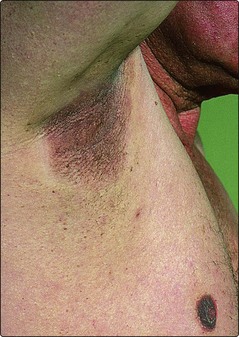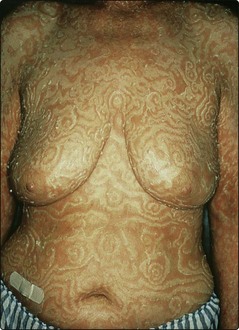Associations with malignancy
Internal malignancy causes a variety of skin changes (Table 1). Apart from direct infiltration, the mechanisms of these effects are often poorly understood. Some genetic conditions associated with malignancy include characteristic skin lesions that may arise before or after the cancer (e.g. mucosal lentigines in Peutz–Jeghers syndrome associated with bowel malignancy).
Table 1 Cutaneous manifestations of malignancy
| Condition associated | Commonest malignancies |
|---|---|
| Almost always | |
| Acanthosis nigricans | Gastrointestinal tract |
| Erythema gyratum repens | Lung, breast |
| Extramammary Paget’s disease | Apocrine glands |
| Necrolytic migratory erythema | Pancreas (alpha cells) |
| Paget’s disease of the nipple | Breast |
| Skin secondaries | Breast, gastrointestinal, ovary, lung, kidney |
| Occasionally | |
| Acquired ichthyosis | Lymphoma (Hodgkin’s disease) |
| Dermatomyositis | Lung, breast, stomach |
| Erythroderma | T cell lymphoma |
| Flushing | Carcinoid syndrome |
| Generalized pruritus | Hodgkin’s disease, polycythaemia rubra vera |
| Hyperpigmentation | Cachectic malignancy |
| Hypertrichosis | Various tumours |
| Migratory thrombophlebitis | Pancreas, lung, stomach |
| Paraneoplastic pemphigus | B cell lymphoma, thymoma |
| Pyoderma gangrenosum | Leukaemia, myeloma |
| Tylosis | Oesophagus |
Conditions associated with malignancy
The following rare skin eruptions are characteristic and strongly indicate an underlying malignancy:
Acanthosis nigricans
True acanthosis nigricans is uncommon. The flexures and neck typically show epidermal thickening and pigmentation (Fig. 1), and the skin is velvety or papillomatous. Warty lesions are seen around the mouth and on the palms and soles. Benign acquired acanthosis nigricans is more frequent and describes similar milder changes, seen with obesity or endocrine disorders such as insulin-resistant diabetes or acromegaly. Very rarely, acanthosis nigricans is inherited and appears in childhood or at puberty. In the malignancy-associated type, usually found in a middle-aged or elderly patient, the cancer is most commonly of the gastrointestinal tract. Growth factors, released from the tumour or associated with the endocrine disorder, cause the skin changes. The underlying disease must be identified and treated.
Erythema gyratum repens
Erythema gyratum repens is an exceptionally rare pattern of concentric scaly rings of erythema that shift visibly from day to day (Fig. 2). The appearance resembles wood grain. An underlying neoplasm, frequently a carcinoma of the lung, is almost invariably detected.











